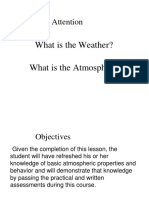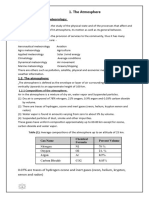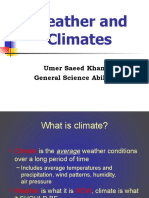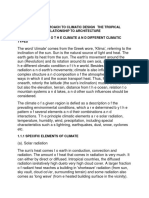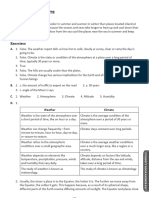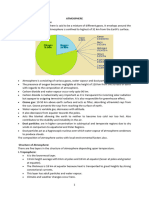L1: Tropical Design Climate Change
L1: Tropical Design Climate Change
Uploaded by
ReeseCopyright:
Available Formats
L1: Tropical Design Climate Change
L1: Tropical Design Climate Change
Uploaded by
ReeseOriginal Title
Copyright
Available Formats
Share this document
Did you find this document useful?
Is this content inappropriate?
Copyright:
Available Formats
L1: Tropical Design Climate Change
L1: Tropical Design Climate Change
Uploaded by
ReeseCopyright:
Available Formats
TD
L1: TROPICAL DESIGN differences, physical impurities, electric content in
the air, and the like, not considered in this study).
CLIMATE CHANGE
is generally defined as a significant variation of
average weather conditions—say, conditions
becoming warmer, wetter, or drier—over several
decades or more. It's the longer-term trend that
differentiates climate change from natural weather
variability
CAUSES AND IMPACTS OF CLIMATE CHANGE
Changes observed in Earth’s climate since the early
20th century are primarily driven by human
activities, particularly fossil fuel burning, which
increases heat-trapping greenhouse gas levels in
Earth’s atmosphere, raising Earth’s average surface
temperature.
These human-produced temperature increases are
commonly referred to as global warming. L2: INTRODUCTION TO CLIMATIC DESIGN
I. BIOCLIMATIC APPROACH
Natural processes can also contribute to climate
change, including internal variability (e.g., cyclical
ocean patterns like El Niño, La Niña and the Pacific
Decadal Oscillation) and external forcings (e.g.,
volcanic activity, changes in the Sun’s energy
output, variations in Earth’s orbit).
DESIGN WITH NATURE
By Ian Mcharg
By “design with nature” McHarg meant that the way
we occupy and modify the earth is best when it is
planned and designed with careful regard to both
the ecology and the character of the landscape. II. THE ATMOSPHERE
Earth's atmosphere: a thin layer of gases that
THE BIOCLIMATIC APPROACH surrounds the Earth
The bioclimatic design approach could be simply 99% nitrogen and oxygen, and 1% of other gases
described that architecture design methods could divided into layers as you can see in the picture
take advantage of the climate through the right
application of design elements and building
technology to energy saving as well as to ensure
comfortable conditions into buildings
(Olgyay,1973).
The major elements of climatic environment which
affect human comfort can be categorized as: air
temperature, radiation, air move- ment, and
humidity. (There are others too, such as chemical
TD
THE LAYERS OF THE ATMOSPHERE CLIMATE
1. Troposphere (0-10 km) average weather conditions of a place, usually
• lowest region in the Earth's atmosphere measured over one year.
• weather and clouds occur Includes temperature and rainfall
temperature decreases as altitude increases "Climate" - integration in time of weather
conditions, characteristics of a certain geographical
2. Stratosphere (10-50km) location.
earth's ozone layer formed by the differential solar heat input and the
absorbs a lot of ultraviolet rays which are dangerous uniform heat emission over the earth's surface.
for human beings
temperature increases at this layer IV. CLIMATIC ELEMENTS
Temperature
3. Mesosphere (50-80 km) Humidity
Temperatures quickly decrease as height increases Air Movement
(about –90oC) Precipitation
Cloud Cover
4. Thermosphere (80-500km) Solar Radiation
Temperatures rise again and can exceed 1,000oC Sunshine duration
5. Exosphere (500-1,280km) 1. Temperature
last layer of the Earth's atmosphere 1.1. Temperature
separates the Earth from the outer space the degree or intensity of heat present in a
substance or object, especially as expressed
according to a comparative scale and shown by a
thermometer or perceived by touch.
4 Factors Affecting Temperature
a. Latitude
Temperatures decrease as you move away from the
equator.
This is because the Sun’s rays are dispersed over a
larger area of land than in the equator.
In addition, polar regions are colder because the
Sun’s rays have further to travel than on the
equator.
o Sun rays go directly over the Equator areas,
temperatures are higher there.
III. WEATHER AND CLIMATE
WEATHER
day to day condition of the atmosphere
includes temperature, rainfall and wind.
• "Weather" is the set of atmospheric conditions
prevailing at a given place and time.
TD
• Coastal winters are mild and summers are
cool.
• Innland areas - temperatures are high in the
summer and cold in the winter.
Greenhouse Effect
the rise in temperature that the Earth experiences
because certain gases in the atmosphere like water
vapor, carbon dioxide, nitrous oxide, and methane
trap energy from the sun.
b. Water Currents
the circulation of water and air
Warm air and water are transported up towards the
poles
• Cool air and water are transported down 2. Humidity
towards the equator • a quantity representing the amount of water
vapor in the atmosphere or a gas
3. Air movement
• caused by temperature or pressure
differences and is experienced as wind
• both wind speed and direction are indicated.
c. Altitude
• Temperatures decrease with height
• air is less dense and cannot hold heat as
easily
• Temperatures rise 6oC every 1,000 m high.
d. Distance from the sea
• Land heats and cools faster than the sea.
• Coastal areas have a lower temperature than 3.1. Atmospheric Pressure
inland areas. • The weight of air on the earth's surface
TD
• You can see pressure on a weather map with • tiny droplets of water form clouds
lines called isobars. • complex forces make the water droplets fall
as rainfall.
Low pressure
• occurs when air becomes warmer
• air becomes lighter and it rises forming
clouds and rain
• Areas of low pressure are called. depressions
High pressure
• occurs when air becomes colder
• air becomes heavier and it sinks
• Areas of high pressures are called
anticyclones = cold clear days in winter and
hot and sunny days in summer
Barometer – measures air pressure
3.2. Wind
• Wind is the movement of air masses from
high pressure areas (highs) to low pressure
areas (lows).
• weather vane indicates the wind direction
• anemometer measures its speed in km/h.
• Anticyclones send out winds and they are
attracted by depressions
4. Precipitation
• the total amount of rain, hail, snow, dew,
measured in rain gauges and expressed in
mm per unit time (day, month, year).
• water which falls to the earth in different
forms: rain, snow, sleet or hail
• occurs when water vapour cools
• when the air reaches condensation point:
the water vapour condenses and forms tiny
droplets of water
You might also like
- Situational Judgement TestDocument130 pagesSituational Judgement TestRJM100% (3)
- ECM PresentationDocument33 pagesECM PresentationBabarkhan Mujawar100% (1)
- O Level Geography Notes Physical NotesDocument157 pagesO Level Geography Notes Physical NotesBrendon T100% (3)
- Rongda Enduser Manual 1Document19 pagesRongda Enduser Manual 1Anonymous WD109UakyNo ratings yet
- Climate and Human ComfortDocument63 pagesClimate and Human Comfortprem kumar indra deviNo ratings yet
- AtmosphereDocument21 pagesAtmosphereaguilarjankirstenNo ratings yet
- Week 1 - WEATHER AND CLIMATEDocument3 pagesWeek 1 - WEATHER AND CLIMATExs5kqfmc7cNo ratings yet
- Unit 1Document62 pagesUnit 1Suruthi ATKNo ratings yet
- BST161 1.0 - ClimateDocument48 pagesBST161 1.0 - ClimateNuriy NabihahNo ratings yet
- Presentation BS281 Week 02Document30 pagesPresentation BS281 Week 02Mazen AymanNo ratings yet
- Atmosphere BasicsDocument12 pagesAtmosphere BasicsAbhik SahaNo ratings yet
- Air Conditioning Engineering (BAB 5) - Fauzan Aziz R - 2002322007Document16 pagesAir Conditioning Engineering (BAB 5) - Fauzan Aziz R - 2002322007Fauzan Aziz RahmatilahNo ratings yet
- Climatology 1Document11 pagesClimatology 1Ritu RaniNo ratings yet
- TNPSC Geography Study Material in English by GovtDocument105 pagesTNPSC Geography Study Material in English by GovtPriyanka KNo ratings yet
- Weather and ClimateDocument26 pagesWeather and ClimateNinafaith BrionesNo ratings yet
- Class 9 Atmosphere and InsolationDocument5 pagesClass 9 Atmosphere and InsolationzackjabeenNo ratings yet
- ES1 The AtmophereDocument44 pagesES1 The AtmophereErica EsmendaNo ratings yet
- Atmosphere HandoutDocument82 pagesAtmosphere HandoutalyssaNo ratings yet
- Tab 2 PMI Atmospheric BasicsDocument95 pagesTab 2 PMI Atmospheric BasicsAhmed ElgoharyNo ratings yet
- 1A - Hazardous EarthDocument16 pages1A - Hazardous Earthalan.swinney9No ratings yet
- Meteorology 461Document31 pagesMeteorology 461fareselhashimNo ratings yet
- Fators Affecting Climate (Global Climatic Factors)Document28 pagesFators Affecting Climate (Global Climatic Factors)Bishal RanaNo ratings yet
- Weather and ClimateDocument3 pagesWeather and ClimateZhang Wenjie ShaunNo ratings yet
- Chaper 9Document8 pagesChaper 9vashuok081No ratings yet
- Module 1 (CCS)Document47 pagesModule 1 (CCS)nithya.a.sNo ratings yet
- bc10wbch10 Sec2Document9 pagesbc10wbch10 Sec2api-283427523No ratings yet
- Climate - WeatherDocument41 pagesClimate - WeatherHamza MujahidNo ratings yet
- ClimatologyDocument244 pagesClimatologylutendomawela0No ratings yet
- Important Approach To Climatic DesignDocument37 pagesImportant Approach To Climatic DesignJan Adrielle VeniceNo ratings yet
- SB 9Document2 pagesSB 9Michael Mimi BesraNo ratings yet
- Weather and Climate StudentsDocument60 pagesWeather and Climate StudentsRai PepitoNo ratings yet
- Social Unit 1Document7 pagesSocial Unit 1Anderi JeiluNo ratings yet
- 2011 Lecture 5 Why Are There Differences in Ecosystems Part IDocument40 pages2011 Lecture 5 Why Are There Differences in Ecosystems Part IJohn Zephyr TyskaNo ratings yet
- Air Pollution Quiz Ce1 Tekiner, Aldrien P.Document7 pagesAir Pollution Quiz Ce1 Tekiner, Aldrien P.Aldrien TekinerNo ratings yet
- CST 206 Lecture TemperatureDocument7 pagesCST 206 Lecture Temperaturejaymike5423No ratings yet
- The Atmosphere: Ma. Salve T. AntaranDocument84 pagesThe Atmosphere: Ma. Salve T. AntaranFlora Mae Masangcay DailisanNo ratings yet
- AtmósferaDocument20 pagesAtmósferaPatrick CastleNo ratings yet
- MST2 Week14 Climate Change and Environmental AwarenessDocument40 pagesMST2 Week14 Climate Change and Environmental Awarenesshxzhjcwbh5No ratings yet
- DM Module 1Document93 pagesDM Module 1rain MCNo ratings yet
- ClimateDocument54 pagesClimateJolly RiveraNo ratings yet
- Engg10k1 Ss Geo Unit 2 Heating of The Atmosphere MemoDocument6 pagesEngg10k1 Ss Geo Unit 2 Heating of The Atmosphere MemoCrizel WinkelNo ratings yet
- Module 1 DMDocument69 pagesModule 1 DMsanemsinoritaNo ratings yet
- 3RDFactors That Affect The Climate - OHSPDocument31 pages3RDFactors That Affect The Climate - OHSPJohn Angelo QueseaNo ratings yet
- Grade 9 ScienceDocument8 pagesGrade 9 ScienceChristian jade QuijanoNo ratings yet
- Weather and ClimateDocument20 pagesWeather and ClimateAnord EliasNo ratings yet
- Meteorology: Private Pilot LicenseDocument93 pagesMeteorology: Private Pilot LicenseChristian Cesar C. CebrecusNo ratings yet
- Climate and WeatherDocument31 pagesClimate and WeatherKamran AbdullahNo ratings yet
- Lecture 1 - ClimateDocument26 pagesLecture 1 - ClimateNUR SYAQIRAH TAJUDDINNo ratings yet
- EarthSci - AtmosphereDocument2 pagesEarthSci - Atmospherekyliegalang1022No ratings yet
- Reviewer Atmos.Document7 pagesReviewer Atmos.JeahNo ratings yet
- gcse-9-1-geography-b-knowledge-organiser-paper-1-global-geographical-issuesDocument13 pagesgcse-9-1-geography-b-knowledge-organiser-paper-1-global-geographical-issuesashrafihaider5No ratings yet
- CH 9Document9 pagesCH 9anil.gelra5140No ratings yet
- Atmospheric Weather VariablesDocument3 pagesAtmospheric Weather VariablesSachin Srivastava100% (1)
- CLIMATOLOGY Best NOTES 1Document71 pagesCLIMATOLOGY Best NOTES 1Remy DeezNo ratings yet
- Warm HumidDocument51 pagesWarm HumidShafnaFawazNo ratings yet
- Weather - Geography Form 1 Notes.: Daily Atmospheric Conditions of A Place at A Particular TimeDocument22 pagesWeather - Geography Form 1 Notes.: Daily Atmospheric Conditions of A Place at A Particular Timemakarcyber42No ratings yet
- AtmosphereDocument12 pagesAtmospherelovemhiz431No ratings yet
- Introduction To ClimatologyDocument36 pagesIntroduction To ClimatologyMehak Saxena100% (1)
- AtmosphereDocument111 pagesAtmosphereIwan SetiawanNo ratings yet
- Unit I: Climate and Human ComfortDocument66 pagesUnit I: Climate and Human ComfortAtshayaNo ratings yet
- Questions and Answers about: Planet EarthFrom EverandQuestions and Answers about: Planet EarthRating: 3 out of 5 stars3/5 (1)
- BW ASGroupWebInterfaceAdminGuidePart2 R230Document519 pagesBW ASGroupWebInterfaceAdminGuidePart2 R230jon.mc.kwanNo ratings yet
- Business Multiple ChoiceDocument3 pagesBusiness Multiple ChoiceAbi C. WareNo ratings yet
- G.R. No. L-44059Document4 pagesG.R. No. L-44059Hanifa D. Al-ObinayNo ratings yet
- Royal EnfieldDocument9 pagesRoyal EnfieldNAVEEN KUMAR KATTANo ratings yet
- Republic Act No. 7610 - Child Abuse LawDocument24 pagesRepublic Act No. 7610 - Child Abuse LawLeo Cruz100% (6)
- Gbolonyo Kofi - Tese Hagbe 2009Document602 pagesGbolonyo Kofi - Tese Hagbe 2009Gustavo Tanus100% (2)
- Invisible ManDocument13 pagesInvisible ManRamNo ratings yet
- Trung Tâm Anh NG Nhung PH M 27N7A KĐT Trung Hòa Nhân Chính - 0946 530 486 - 0964 177 322Document5 pagesTrung Tâm Anh NG Nhung PH M 27N7A KĐT Trung Hòa Nhân Chính - 0946 530 486 - 0964 177 322Trung PhamNo ratings yet
- Efficient Designs of Multiported Memory On FPGA: Bo-Cheng Charles Lai, Member, IEEE, and Jiun-Liang LinDocument12 pagesEfficient Designs of Multiported Memory On FPGA: Bo-Cheng Charles Lai, Member, IEEE, and Jiun-Liang LinManjunath BadigerNo ratings yet
- Terms & Conditions: HSBC's Credit Card ProductsDocument22 pagesTerms & Conditions: HSBC's Credit Card ProductsJohnNo ratings yet
- Port City International University: Submitted To Farzana Rashid LecturerDocument5 pagesPort City International University: Submitted To Farzana Rashid LecturerComputer SolutionNo ratings yet
- Itdg (Oil Industry Transport Discipline Guidelines) Word FileDocument16 pagesItdg (Oil Industry Transport Discipline Guidelines) Word Filevikram.jay2005No ratings yet
- Gnav TheoryDocument9 pagesGnav TheoryMNo ratings yet
- K - 12 Budget of WorkDocument12 pagesK - 12 Budget of WorkMaryHazelClaveBenigaNo ratings yet
- June 2 1Document58 pagesJune 2 1rendra kurniaNo ratings yet
- Skills Education: Shahenaz KapadvanjiDocument1 pageSkills Education: Shahenaz KapadvanjiKhyati KamdarNo ratings yet
- CORPORATION LAW 2019 Case ListDocument2 pagesCORPORATION LAW 2019 Case ListJose Ramir LayeseNo ratings yet
- Sun Microsystems A Good Strategic Fit For OracleDocument5 pagesSun Microsystems A Good Strategic Fit For OracleJosé F. PeñaNo ratings yet
- Quality Assurance Plan For Civil4mDocument3 pagesQuality Assurance Plan For Civil4mMohammed Abdul BaseerNo ratings yet
- Congress Rule (14 Marks)Document1 pageCongress Rule (14 Marks)Aariz Asher75% (4)
- Name Hareem Fatima Roll Num El-021 Section D Second Year Electronics Im PresentationDocument4 pagesName Hareem Fatima Roll Num El-021 Section D Second Year Electronics Im Presentationtooba mukhtarNo ratings yet
- 6GD S4CLD2302 BPD en UsDocument129 pages6GD S4CLD2302 BPD en UsFurqanNo ratings yet
- Project Management AgreementDocument6 pagesProject Management AgreementAHMADNo ratings yet
- Edinburgh Military Tattoo Program 2012Document31 pagesEdinburgh Military Tattoo Program 2012john_crawford_1100% (1)
- Development ControlsDocument4 pagesDevelopment ControlsRolf RingorNo ratings yet
- Bai Tap Tieng Anh Lop 5 Unit 14 Nang Cao What Happened in The StoryDocument5 pagesBai Tap Tieng Anh Lop 5 Unit 14 Nang Cao What Happened in The StoryHang TranNo ratings yet


















